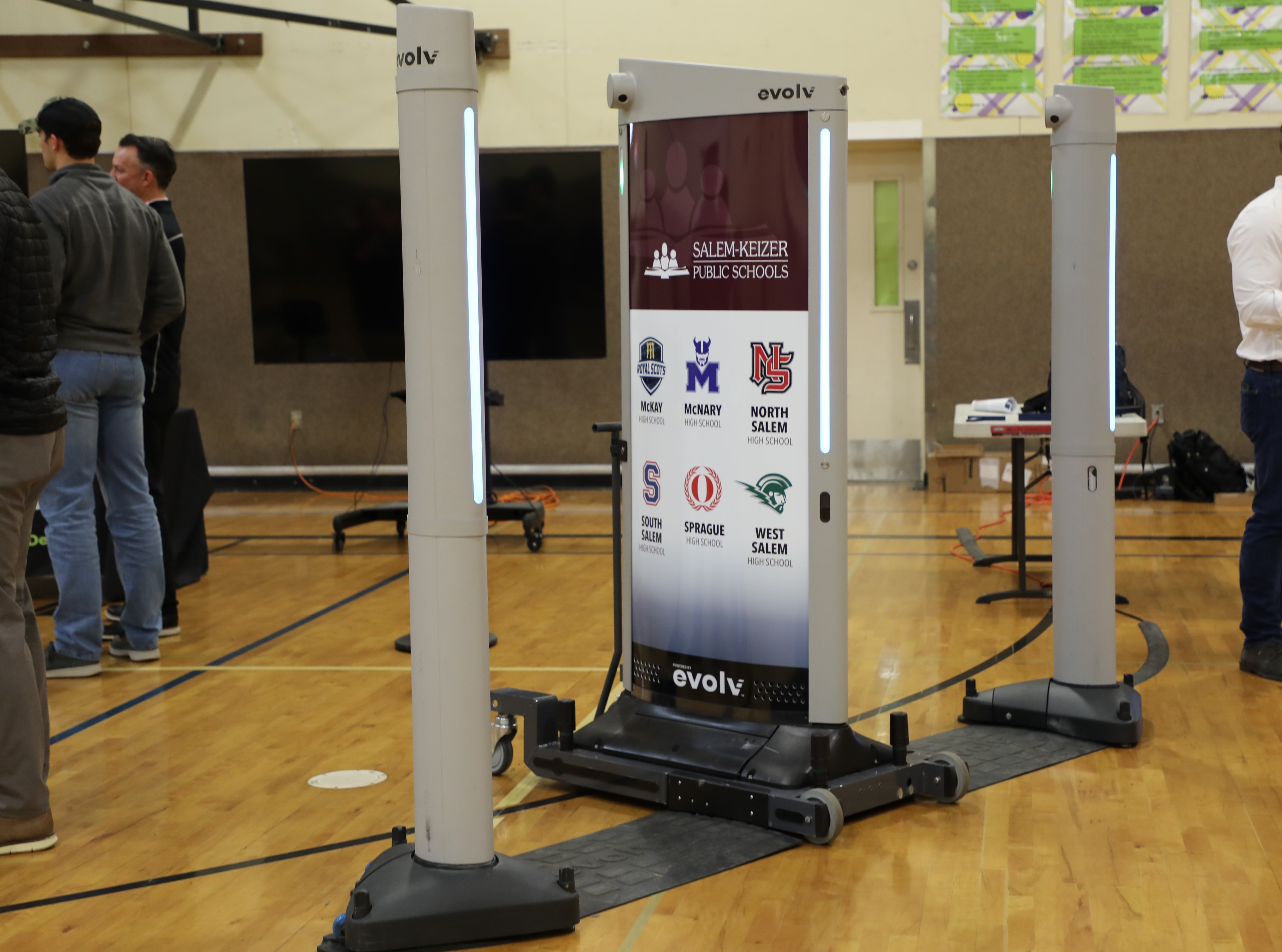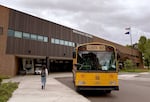
A weapon detection system was on display during a public viewing demonstration in Salem, Ore., in March 2024.
Courtesy of Salem-Keizer Public Schools
After the fatal shooting of a Salem high schooler last March — and rising concerns of gun violence in schools across the country today — Salem-Keizer Public Schools leaders say they need another layer of prevention to protect students.
Plans to detect weapons at multiple school sites across Oregon’s second-largest school district, which enrolls more than 40,000 students, is the biggest such step in the state, possibly the region. The decision comes as multiple school districts are wrestling with safety and security concerns.
Just this week, the handling of security threats at Gresham High School forced the principal there to resign, and in Bend, a 12-year-old student was arrested for bringing a loaded gun to their middle school.
In an attempt to further prevent threats like these in Salem-Keizer, the district is installing weapons detectors across its high schools, with plans to add them to schools for younger students in the near future.
“What a privilege it is to be at a press conference that is not one of the 44 that have already happened in America [this year] related to school shootings,” Superintendent Andrea Castañeda said to reporters Friday morning. “This is a press conference where we get to talk about what we’re doing to prevent a tragedy, not live through the aftermath of one.”
Castañeda described the moment as a national impasse in the country’s conversation about guns.
“What we have today is the responsibility to talk about what school districts do proactively and decisively to increase the conditions for safety,” she said.
The biggest announcement is Salem-Keizer’s rollout of weapons detectors in all six of its comprehensive high schools — South, McKay, McNary, North, Sprague and West — this school year, with a likely expansion to middle schools next year.

Students walk the halls of South Salem High School in Salem, Ore., Tuesday, Sept. 17, 2019.
Elizabeth Miller / OPB
The more than $1.5 million expected cost comes on the heels of the district having to cut tens of millions of dollars — and hundreds of positions as a result — from this year’s budget. District leaders say this will be paid from separate, one-time funding.
Castañeda said the decision to expand detectors was “deliberate and measured” and made after engaging researchers and community members. The district conducted a pilot program at South Salem High at the end of last school year, weeks after the fatal shooting of a student at a nearby park during lunch.
Chris Baldridge, director of Safety and Risk Management Services for the district, said the pilot program at South Salem limited which entrances students can use to enter the building. This is something they are already starting to replicate at other high schools.
There are also “window films” throughout the school that allow students to see outside but stop outsiders from looking in. Additionally, there are new alarms on doors that aren’t meant to be used for entering or exiting the school.
These, along with stricter cell phone policies this year, are all precautions in addition to the detectors.
“We are responsible for the safety of the most precious people in your lives and members of our community,” Castañeda said. “We have to take action with reasonable measures that are within our reach. Weapons detection is not a solution to the underlying problem of fear, violence, and firearms in our community. It is simply an additional, comprehensive layer to protect schools.”
How do the detectors work?
The weapons detectors are very similar to what someone might walk through to enter a stadium for a game or concert.
When students walk into the building, they’re greeted by security staff. They have to pause their phones and remove their earbuds, but other than their school laptops, they don’t have to take anything out of their bags or pockets.
Once they walk through, if an alert goes off, Baldridge said the student steps to the side and places their bags or items on a table. They can open them for security, or security can open them. Staff inspect the items as the student walks back through the detector.
If the alert goes off again, it can triangulate where on the body it’s detecting metal. Baldridge said they don’t do pat-downs but will ask the student to show anything in that area.
The vast majority of the time, Baldridge said, the first alert goes off because of an instrument or something in someone’s backpack, and they’re cleared the first time through. But if they have cell phones, keys and other things all crammed into a jacket pocket, that will still set off the alert the second time through — and if it’s a weapon, they will narrow down to it.
Castañeda said the system does not require additional staff, but it does require people to use their time differently. The people Baldridge mentioned greeting students at the door are making eye contact and starting their day with conversations, she said.
“At our pilot site, if you were to watch what happens there, you’d see that there are no fewer than two staff members greeting every student before they walk through the door every morning,” Castañeda said. “And we consider that not to be a concession to weapon detection but a benefit to school culture.”
How much will they cost, and how will the district pay for them?
Castañeda said the cost is still being finalized, but it will be higher than they originally anticipated — somewhere over $1.5 million for all the high schools, which she said “are the most complicated and expensive sites.”
About half of the costs will be paid from a restricted settlement with e-cigarette maker JUUL Labs. The agreement requires the money to be used in specific ways, including to reduce vaping. While no firearms were seized during the South Salem pilot program, security staff did seize knives and vape pens.
The second half of the high school costs will be paid for out of the district’s Risk Fund, which is designed for one-time use to address core safety issues.
The money is used for the equipment and installation. It does not have to pay for employees as these systems are staffed by security personnel who already work at the school.
Castañeda said the district doesn’t have a plan yet to pay for the middle school detectors next year.
Do any other districts in Oregon use metal detectors this way?
This is not a common practice in the Pacific Northwest.
“I don’t believe there are any other districts in Oregon, or frankly, I am not clear that there are even districts in Washington that are doing this,” Castañeda said.
“And this is not a thing that Salem-Keizer wishes to be first in,” she added, “but we’re willing to be first because we do prioritize safety and comprehensive measures.”
Portland Public Schools is the only district larger than Salem-Keizer in Oregon. PPS tested metal detectors during football games at McDaniel High School in Portland last year, but they do not have them at the entrances to school buildings, as Salem-Keizer is planning to do.
Will the systems have a positive impact on Salem-Keizer campuses?
The answer is mixed — and it depends on who you ask. However, after the South Salem pilot program, district leaders believe the systems will help create a sense of safety.
Students, parents and staff at South Salem High were surveyed about their experience with the pilot detectors. More than 1,100 people responded, most of whom were students. South Salem enrolled more than 2,000 students during the 2022-23 school year, according to the latest available state data.
Nearly 50% of student respondents and almost 75% of staff reported feeling safer at school after implementing the detectors.
However, when asked if the detectors make them feel welcome at their school, a third said no, and about 40% were neutral.
Only about a quarter, 26%, said the detectors made them feel welcome at South Salem High. This was an improvement from the spring pre-survey, in which only 20% said they believed the detectors would make them feel more welcome.

The Salem-Keizer Public Schools logo photographed outside the district's Student Support Services Center on Dec. 7, 2023, in Salem, Ore.
Natalie Pate / OPB
During the pilot, behavior and attendance violations decreased, and attendance improved — though the report says the attendance increase cannot be attributed to the detectors alone. As people got used to the detectors, concerns about them decreased.
Castañeda described these data points as wins, saying the key question they wanted to answer was whether they could use a weapon detection system in addition to layered safety without sacrificing attendance.
In the pilot, attendance marginally increased, she said, and infractions related to behavior, specifically cutting class, decreased.
“So, the report is clear: We can’t say that weapon detection is the cause of increased attendance,” she said, “but we can say that it did not result in a reduction of daily attendance on the safety feature.”
Castañeda emphasized that any move that helps half of students and three-quarters of staff feel safer is a material improvement.
When asked why staff reported higher levels of feeling safe, Castañeda said she didn’t have a set answer. But she had a theory.
“I think that educators feel very responsible for the safety of students,” she said. “In recent national surveys, the majority of educators report that they think sometimes or often about the possibility of violence in their schools, and it’s because they’re not thinking about just themselves. They’re thinking about every young person in the building.”
Castañeda said they learned a lot from the pilot program and will continue to learn more and improve the systems as they are implemented in more schools.
How do student leaders feel about it?
Kaiden Armstead from McKay High School and Sofia Castellanos from South Salem High are student advisors to the Salem-Keizer school board.
While they don’t represent the feelings of all students, they both spoke in favor of the detectors at the Friday press conference with Supt. Castaneda. One spoke from experience with the detectors at South Salem High; the other spoke from a desire to feel safer.
“Our world used to live in a time where weapon detection systems … would prove to be more harmful than good, but that’s simply no longer the time that we live in today,” Armstead said. “The time we live in today is a time where gun violence is one of the leading causes of death among teenagers. It definitely causes a sense of fear with teenagers going to school.”
Armstead said this move is essential, and it’s a way for the district to show that the safety of students matters.
“Walking through the halls every day, I always hear talk about how students want the weapon detection systems,” he said. “Kids are definitely talking about it all the time.”

A school bus in front of McKay High School in Salem, Ore. on May 22, 2024.
Elizabeth Miller / OPB
Castellanos remembers the lockdown at South Salem last year, coming back from lunch and heading to class, when one of her peers was fatally shot. When the detectors first went in, she said students complained, largely because it was something new and different. One of the biggest concerns was that it would make students late to class, but she said that’s since been debunked — unless you show up to school late and set off the alarm with something in your bag.
She said South is a school that prides itself on school spirit, and that has not diminished. Freshmen especially have taken it in stride because they don’t know any other version of South Salem High.
“I would rather, like, get stopped for my umbrella setting the metal detector off than a gun just going through the school and not getting caught,” she said.
Why was this a district administration decision instead of a school board decision?
School boards in Oregon operate through a policy governance structure, while district leaders make the calls for daily operations. In other words, the board tells the district where they’re sailing, but district leaders are responsible for steering the ship.
In this case, as was the case for removing school resource officers from Salem-Keizer schools a few years ago, the decision ultimately lands with the superintendent and executive team.
That said, it’s likely the school board will hear from community members during meetings if there’s any pushback.
Chair of the school board Cynthia Richardson spoke at the press conference Friday, saying she spoke only as an individual and not on behalf of the board. Richardson, who has been an educator, parent and grandparent in the district for decades, said she thinks this is the right decision.
“For years, we have made the change required to lead in safety,” she said. “This is a real-time example of taking difficult but necessary action to do what we must do to support the safety of our schools.”
How will the district address bias in the detection system?
In addition to the financial cost, added weapons detectors come with social costs — such as a possible public perception that Salem-Keizer schools are somehow more dangerous than others by needing detectors. There’s also the cost to students who’ve said they don’t feel safer with more policing and security measures in schools.
When the pilot program started, the district received pushback, especially from communities of color who advocated against school resources officers and other measures, detectors included.
They argue these measures contribute to the school-to-prison pipeline by possibly leading to discrimination or higher rates of disciplinary measures against students of color or other historically marginalized groups.
Castañeda said she has met with many of these groups since. But also, at least the first phase of the detection system, she said, helps eliminate bias because the systems are “indifferent to identity.” They go off no matter the person stepping through.
“[The detectors are] simply seeking high-density metal,” she said, “And that is actually better, safer, less biased than relying on any number of people every day to wand or scan or do random bag checks.”
Castañeda said the district has also worked carefully to train security staff to ensure the first interaction is one that is actually presuming in every way that the entire experience is going to be positive — saying good morning to the student and keeping their voices positive and welcoming even if the alert goes off, for example.
“It’s not an interrogation,” she said. “It’s just a follow-up.”
Ultimately, Castañeda said she’s focused on a simple guideline: weapons do not belong at school.
“There is no place for them. There is no tolerance for them,” she said. “And if a person wishes to walk through our doors with a weapon of any sort and an intent to harm someone, it is our unfaltering position that they should not pass through our front doors, and the attempt to do so will likely result in consequences.
“The clarity of that position and the simplicity of the fact that weapons do not belong in our building,” she added, “in my view, supersedes other skepticism and doubts about a comprehensive safety measure.”
Salem-Keizer already has a nationally recognized threat assessment system and a policy limiting even concealed carry weapons on campuses. Why is this needed?
Castañeda said that adding weapons detectors isn’t just an extra layer of protection; it’s a necessary one.
“We’re very proud of our threat detection system and all of the aspects of our safety systems, but pride does not keep young people safe,” she said.
“Pride does not keep weapons or threats out of buildings. Vigilance and a commitment to constantly assessing conditions and opportunities to improve is what keeps our community and our schools safe.”



